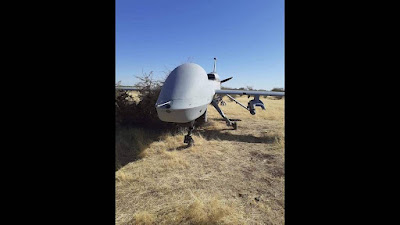Russian officials routinely state that they are not just fighting Kyiv’s forces, but also U.S. and NATO infrastructure. On November 9, the Wall Street Journal reported that Biden was concerned the transfer of the Gray Eagles “could escalate the conflict and signal to Moscow that the U.S. was providing weapons that could target positions inside Russia.”
NOTE: The General Atomics MQ-1C Gray Eagle (previously the Warrior; also called Sky Warrior and ERMP or Extended-Range Multi-Purpose) has a range of 250 miles or more.
*(Image credit: An Army “Gray Eagle” Unmanned Aircraft System flies over the U.S. Army Dugway Proving Ground in Dugway, Utah, on Dec. 10, 2020. Photo: Becki Bryant/U.S. Army Dugway Proving Ground)
Democratic and Republican Senators Demand Transfer of Gray Eagle Drone to Ukraine
Joe Manchin, Lindsey Graham, and 14 other U.S. senators demand that Biden give Ukraine a top-tier U.S. drone.
"In their November 22 letter, the senators — including Republicans Lindsey Graham and Chuck Grassley as well as Democrats Richard Blumenthal and Mark Kelly — wrote, “Most importantly, armed [drones] could find and attack Russian warships in the Black Sea, breaking its coercive blockade and alleviate dual pressures on the Ukrainian economy and global food prices.”
✓ The senators asserted, “A Russian victory over Ukraine would significantly damage American security and prosperity.”
As The Intercept noted on November 18, the proliferation of drone warfare in Ukraine has been fueled by both sides — with Russia utilizing Iranian-made Shahed drones in swarm attacks against Ukrainian targets, including civilian infrastructure. The U.S. and other NATO countries have given Kyiv some 2,500 Switchblade and Phoenix Ghost “suicide” drones, which effectively function as small, remote-controlled cruise missiles. Ukraine has also been using larger Turkish-manufactured Bayraktar TB-2 drones, which are a cheaper and less powerful version of the premiere U.S. drones used widely in “counterterrorism” operations in the Middle East and Africa.*
* BLOGGER INSERTS
US Africa Command says one of its drones, an apparently armed Gray Eagle, malfunctioned in Niger
:quality(70)/cloudfront-us-east-1.images.arcpublishing.com/archetype/KQXQAW7XIZHB5CMZDATHNDYXBA.jpg)
An MQ-1C Gray Eagle drone, operated by U.S. Africa Command made an emergency landing near Agadez, Niger, on Saturday, a U.S. Africa Command spokesman told Military Times.
“The aircraft experienced a mechanical malfunction while conducting a routine mission in support of operations in the region,” Air Force Col. Christopher Karns told Military Times.
An investigation into the cause of the malfunction will take place, he said.
“The aircraft is under observation by U.S. forces with host nation cooperation and assistance,” Karns said. “Assessment and the process of recovery of the aircraft and safeguarding the site is underway. Due to force protection and operational considerations this is about all I can say. Early indications reflect a mechanical issue but an investigation is underway.”
Karns told Military Times the drone is an MQ-1C Gray Eagle, a multipurpose drone that “provides reconnaissance, surveillance, target acquisition, command and control, communications relay, signals intelligence, electronic warfare, attack, battle damage assessment, and manned-unmanned teaming capabilities,” according to the Defense Department.
AFRICOM’s Twitter account confirmed the loss of the aircraft after being asked about social media postings of what appear to be an armed Gray Eagle drone, with a Hellfire missile still under its wing.
RELATED
:quality(70)/cloudfront-us-east-1.images.arcpublishing.com/archetype/ATUYJGK7NFGVDAOB3QU4CMCLRI.jpg)
“We continue to work with African partners providing a range of assistance in the region to include a valuable threat detection capability via aerial overwatch,” said Karns.
About Howard Altman
Howard Altman is an award-winning editor and reporter who was previously the military reporter for the Tampa Bay Times and before that the Tampa Tribune, where he covered USCENTCOM, USSOCOM and SOF writ large among many other topics.
Gray Eagle Crash in Southern Iraq
Photos posted on Jul. 21 on Twitter show a crashed (largely intact) MQ-1C Gray Eagle with U.S. Army markings.
The 160th Special Operations Aviation Regiment (Airborne) is known to operate 12 Gray Eagles (along with a fleet of smaller RQ-11B Raven and RQ-7 Shadow RPAS, that are used for ISR (Intelligence Surveillance Reconnaissance) task in support to Special Ops.
US Army Upgrades Gray Eagle to Support Multi-Domain Operations - Defense Update:
"General Atomics-Aeronautical Systems, Inc. (GA-ASI) began the first installation of factory upgrades to a Gray Eagle-Extended Range (GE-ER) Unmanned Aircraft System to enhance its capabilities to support Multi-Domain Operations (MDO). The MDO upgrade follows a series of demonstrations that showcased GE-ER’s persistent stand-off survivability with stand-in capabilities and up to 40 hours of endurance. Under the current program, the U.S. Army-funded program includes two aircraft. Flight tests and qualifications will start later this year.
Modernization efforts focus on increased capability and survivability in a large-scale combat operations environment. The modernization efforts ensure that the Army’s MQ-1C GE-ER (MDO) can operate and thrive in a degraded navigation environment and provide high fidelity situational awareness through a suite of long-range sensors.
According to Don Cattell, vice president for Army Programs at GA-ASI, the upgrades ensure Gray Eagle’s support of advanced teaming operations with manned and other unmanned platforms. “We are fully committed to our Army partners to make sure our proven GE-ER is equipped for its role as the designated platform for long-range sensors and Air-Launched Effects (ALEs),” Cattell said. Deploying ALE over the area under surveillance, the Gray Eagle ER (MDO) will serve as the “ALE Mothership” and enable joint forces to maintain situational awareness deep into the battlefield.
GA-ASI worked with the Army to demonstrate MDO capabilities on the Gray Eagle ER at Yuma Proving Grounds, which included fully integrated, internally mounted long-range sensors, ALEs, and laptop-based and handheld control interfaces. The Modernized GE-ER (MDO) incorporates open architecture aircraft and ground systems, advanced datalinks, and an upgraded propulsion system, significantly enhancing the ability to add new capabilities, provide resilience to electronic threats, and expeditionary employment to austere locations.
The upgraded variant utilizes the open architecture design to operate through a scalable command and control (SC2) interface. The SC2 system enables soldiers to operate the GE-ER (MDO) through a laptop or handheld devices. Advancements in artificial intelligence and machine learning help streamline the system’s operation and reduce operator workload.
The SC2 system enables soldiers to operate the GE-ER (MDO) through a laptop or handheld devices. Photo: GA-ASI
Demonstrations focused on enabling a Joint Terminal Attack Controller (JTAC) to control the Electro-optical/Infrared (EO/IR) sensor on a Gray Eagle Extended Range UAS, and rapidly call for direct and indirect fire on an array of targets. The JTAC was able to see GE-ER video, aircraft location, and sensor field of regard utilizing an Android Team Awareness Kit (ATAK) and a TrellisWare TW-950 TSM Shadow Radio. Utilizing the GE-ER’s open architecture, the JTAC was able to send a digital ‘Call for Fires’ to request artillery support and a digital 9-line for Close Air Support with the push of a few buttons. The GE-ER, configured for Multi-Domain Operations, autonomously re-routed its flight path to provide the sensor data that the JTAC requested without commands from the GE-ER operator.
✓ Under another demonstration, GA-ASI demonstrated the use of self-protection pod (SPP) capabilities of the MQ-9 UAS, as part of a Cooperative Research and Development Agreement (CRADA) with U.S. Special Operations Command (USSOCOM), and with the support of the Air National Guard (ANG), the U.S. Navy (USN), and industry partners.
✓ SPP leverages mature Aircraft Survivability Equipment (ASE) to provide full-spectrum awareness and countermeasures. The pod uses Raytheon’s AN/ALR-69A(V) Radar Warning Receiver (RWR) set and Leonardo DRS AN/AAQ-45 Distributed Aperture Infrared Countermeasure (DAIRCM) System that utilizes a single sensor for both 2-color IR missile warning and wide field-of-view gimbal for threat countermeasures.
✓ Both sensors support threat warnings.
✓ In addition, the pod features BAE Systems’ ALE-47 countermeasures dispenser System to release airborne flares, chaff, and the BriteCloud Expendable Active Decoy (EAD), which is a small, expendable self-contained Digital Radio Frequency Memory (DRFM)-based expendable decoy.
✓ The ECM suite is managed by the Terma AN/ALQ-213 Electronic Warfare Management System, which provides the interface, health, status, and command and control for the various systems installed in the pod. that functions as the ASE manager that coordinates between the various threat warning and dispensing systems to automatically dispense the appropriate sequencing pattern and expendables to protect the drone." READ MORE
Soldier Controls MQ-1C Gray Eagle Drone Via Tablet in Latest GA-ASI Demo
Defense contractor General Atomics Aeronautical Systems (GA-ASI) successfully demonstrated enhanced situational awareness and targeting capability of an MQ-1C Gray Eagle in a recent exercise. The Extended Range drone was remotely controlled via an Android-powered tablet by a soldier on ground.
Widely used by the U.S. Army, the Gray Eagle can operate for about 36 hours at altitudes up to 25,000 feet (7,600 m). The aircraft's nose fairing is enlarged to support a synthetic aperture radar or ground moving target indicator (SAR/GMTI) system.
It has a payload capacity of 800 pounds (360 kg) and can be armed with AGM-114 Hellfire missiles and GBU-44/B Viper Strike guided bombs. Its sensors can detect changes in terrain such as tire tracks, footprints, and buried improvised explosive devices by fusing infrared imagery.
GA-ASI latest demonstration took place on April 23rd at Yuma Proving Grounds, Arizona


.jpg)
.jpg)

:quality(70)/cloudfront-us-east-1.images.arcpublishing.com/archetype/CRV7ZDUIGBGLNMI4K35IXG56R4.jpg)
.jpg)
.jpg)
.jpg)





.jpg)
.jpg)
.jpg)


No comments:
Post a Comment